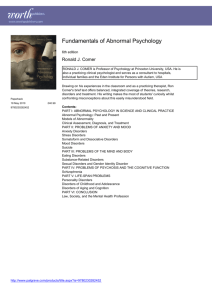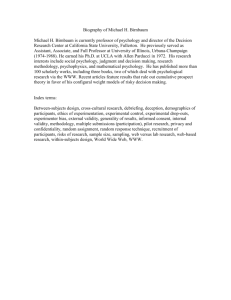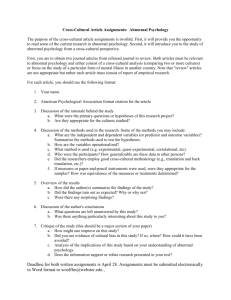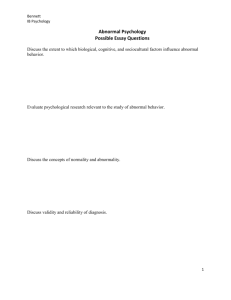AP6_Lecture_Ch04
advertisement
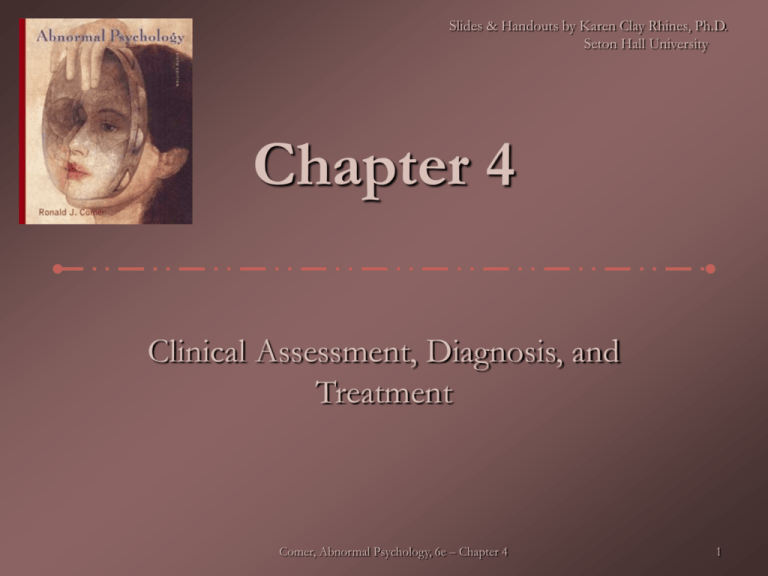
Slides & Handouts by Karen Clay Rhines, Ph.D. Seton Hall University Chapter 4 Clinical Assessment, Diagnosis, and Treatment Comer, Abnormal Psychology, 6e – Chapter 4 1 Clinical Assessment: How and Why Does the Client Behave Abnormally? What is assessment? The collecting of relevant information in an effort to reach a conclusion Clinical assessment is used to determine how and why a person is behaving abnormally and how that person may be helped Focus is idiographic – on an individual person Also may be used to evaluate treatment progress Comer, Abnormal Psychology, 6e – Chapter 4 2 Clinical Assessment: How and Why Does the Client Behave Abnormally? The specific tools used in an assessment depend on the clinician’s theoretical orientation Hundreds of clinical assessment tools have been developed and fall into three categories: Clinical interviews Tests Observations Comer, Abnormal Psychology, 6e – Chapter 4 3 Characteristics of Assessment Tools To be useful, assessment tools must be standardized and have clear reliability and validity To standardize a technique is to set up common steps to be followed whenever it is administered One must standardize administration, scoring, and interpretation Comer, Abnormal Psychology, 6e – Chapter 4 4 Characteristics of Assessment Tools Reliability refers to the consistency of a test A good test will yield the same results in the same situation Two main types: Test–retest reliability To test for this type of reliability, a subject is tested on two different occasions and the scores are correlated – the higher the correlation, the greater the test’s reliability Interrater reliability Independent judges agree on how to score and interpret a particular test Comer, Abnormal Psychology, 6e – Chapter 4 5 Characteristics of Assessment Tools Validity refers to the accuracy of a test’s results A good test must accurately measure what it is supposed to be measuring Three specific types: Face validity – a test appears to measure what it is supposed to measure; does not necessarily indicate true validity Predictive validity – a test accurately predicts future characteristics or behavior Concurrent validity – a test’s results agree with independent measures assessing similar characteristics or behavior Comer, Abnormal Psychology, 6e – Chapter 4 6 Clinical Interviews Face-to-face encounters Often the first contact between a client and a clinician/assessor Used to collect detailed information, especially personal history, about a client Allow the interviewer to focus on whatever topics they consider most important Comer, Abnormal Psychology, 6e – Chapter 4 7 Clinical Interviews Conducting the interview Focus depends on theoretical orientation Can be either unstructured or structured In unstructured interviews, clinicians ask open-ended questions In structured interviews, clinicians ask prepared questions, often from a published interview schedule May include a mental status exam Comer, Abnormal Psychology, 6e – Chapter 4 8 Clinical Interviews Limitations: May lack validity or accuracy Interviewers may be biased or may make mistakes in judgment Interviews, particularly unstructured ones, may lack reliability Comer, Abnormal Psychology, 6e – Chapter 4 9 Clinical Tests Devices for gathering information about a few aspects of a person’s psychological functioning, from which broader information can be inferred More than 500 different tests are in use They fall into six categories… Comer, Abnormal Psychology, 6e – Chapter 4 10 Clinical Tests 1. Projective tests Require that subjects interpret vague and ambiguous stimuli or follow open-ended instruction Mainly used by psychodynamic practitioners Most popular: Rorschach Test Thematic Apperception Test Sentence Completion Test Drawings Comer, Abnormal Psychology, 6e – Chapter 4 11 Clinical Test: Rorschach Inkblot Comer, Abnormal Psychology, 6e – Chapter 4 12 Clinical Test: Thematic Apperception Test Comer, Abnormal Psychology, 6e – Chapter 4 13 Clinical Test: Sentence-Completion Test “I wish ___________________________” “My father ________________________” Comer, Abnormal Psychology, 6e – Chapter 4 14 Clinical Test: Drawings Draw-a-Person (DAP) test: “Draw a person” “Draw another person of the opposite sex” Comer, Abnormal Psychology, 6e – Chapter 4 15 Clinical Tests 1. Projective tests Strengths and weaknesses: Helpful for providing “supplementary” information Have rarely demonstrated much reliability or validity May be biased against minority ethnic groups Comer, Abnormal Psychology, 6e – Chapter 4 16 Clinical Tests 2. Personality inventories Designed to measure broad personality characteristics Focus on behaviors, beliefs, and feelings Usually based on self-reported responses Most widely used: Minnesota Multiphasic Personality Inventory For Adults: MMPI (original) or MMPI-2 (1989 revision) For Adolescents: MMPI-A Comer, Abnormal Psychology, 6e – Chapter 4 17 Clinical Test: MMPI Minnesota Multiphasic Personality Inventory Consists of 550 self-statements that can be answered “true,” “false,” or “cannot say” Statements describe physical concerns; mood; morale; attitudes toward religion, sex, and social activities; and psychological symptoms Assesses careless responding & lying Comer, Abnormal Psychology, 6e – Chapter 4 18 Clinical Test: MMPI Minnesota Multiphasic Personality Inventory Comprised of ten clinical scales: Hypochondriasis (HS) Depression (D) Conversion hysteria (Hy) Psychopathic deviate (PD) Masculinity-femininity (Mf) Paranoia (P) Psychasthenia (Pt) Schizophrenia (Sc) Hypomania (Ma) Social introversion (Si) Scores range from 0 – 120 Above 70 = deviant Graphed to create a “profile” Comer, Abnormal Psychology, 6e – Chapter 4 19 20 Clinical Tests 2. Personality inventories Strengths and weaknesses: Easier, cheaper, and faster to administer than projective tests Objectively scored and standardized Appear to have greater validity than projective tests Measured traits often cannot be directly examined – how can we really know the assessment is correct? Tests fail to allow for cultural differences in responses Comer, Abnormal Psychology, 6e – Chapter 4 21 Clinical Tests 3. Response inventories Usually based on self-reported responses Focus on one specific area of functioning Affective inventories (example: Beck Depression Inventory) Social skills inventories Cognitive inventories Comer, Abnormal Psychology, 6e – Chapter 4 22 23 Clinical Tests 3. Response inventories Strengths and weaknesses: Have strong face validity Rarely include questions to assess careless or inaccurate responding Not all have been subjected to careful standardization, reliability, and/or validity procedures (BDI and a few others are exceptions) Comer, Abnormal Psychology, 6e – Chapter 4 24 Clinical Tests 4. Psychophysiological tests Measure physiological response as an indication of psychological problems Includes heart rate, blood pressure, body temperature, galvanic skin response, and muscle contraction Most popular is the polygraph (lie detector) Comer, Abnormal Psychology, 6e – Chapter 4 25 Clinical Tests 4. Psychophysiological tests Strengths and weaknesses: Require expensive equipment that must be tuned and maintained Can be inaccurate and unreliable Comer, Abnormal Psychology, 6e – Chapter 4 26 Clinical Tests 5. Neurological and neuropsychological tests Neurological tests directly assess brain function by assessing brain structure and activity Examples: EEG, PET scans, CAT scans, MRI Neuropsychological tests indirectly assess brain function by assessing cognitive, perceptual, and motor functioning Most widely used is the Bender Visual-Motor Gestalt Test Comer, Abnormal Psychology, 6e – Chapter 4 27 Clinical Test: Bender Visual-Motor Gestalt Test Comer, Abnormal Psychology, 6e – Chapter 4 28 Clinical Tests 5. Neurological and neuropsychological tests Strengths and weaknesses: Can be very accurate At best, though, these tests are general screening devices Best when used in a battery of tests, each targeting a specific skill area Comer, Abnormal Psychology, 6e – Chapter 4 29 Clinical Tests 6. Intelligence tests Designed to measure intellectual ability Composed of a series of tests assessing both verbal and nonverbal skills Generate an intelligence quotient (IQ) Most popular: Wechsler Adult Intelligence Scale (WAIS) & Wechsler Intelligence Scale for Children (WISC) Comer, Abnormal Psychology, 6e – Chapter 4 30 Clinical Tests 6. Intelligence tests Strengths and weaknesses: Are among the most carefully produced of all clinical tests Highly standardized on large groups of subjects Have very high reliability and validity Because intelligence is an inferred quality, it can only be measured indirectly Comer, Abnormal Psychology, 6e – Chapter 4 31 Clinical Tests 6. Intelligence tests Strengths and weaknesses: Performance can be influenced by nonintelligence factors (e.g., motivation, anxiety, test-taking experience) Tests may contain cultural biases in language or tasks Comer, Abnormal Psychology, 6e – Chapter 4 32 Clinical Observations Systematic observation of behavior Several kinds: Naturalistic Analog Self-monitoring Comer, Abnormal Psychology, 6e – Chapter 4 33 Clinical Observations Naturalistic and analog observations Naturalistic observations occur in everyday environments Can occur in homes, schools, institutions (hospitals and prisons), and community settings Tend to focus on parent–child, sibling–child, or teacher–child interactions Observations are generally made by “participant observers” and reported to a clinician If naturalistic observation is impractical, analog observations are used in artificial settings Comer, Abnormal Psychology, 6e – Chapter 4 34 Clinical Observations Naturalistic and analog observations Strengths and weaknesses: Reliability is a concern Different observers may focus on different aspects of behavior Validity is a concern Risk of “overload,” “observer drift,” and observer bias Client reactivity may also limit validity Observations may lack cross-situational validity Comer, Abnormal Psychology, 6e – Chapter 4 35 Clinical Observations Self-monitoring People observe themselves and carefully record certain behaviors, feelings, or cognitions as they occur over time Comer, Abnormal Psychology, 6e – Chapter 4 36 Clinical Observations Self-monitoring Strengths and weaknesses: Useful in assessing infrequent behaviors Useful for observing overly frequent behaviors Provides a means of measuring private thoughts or perceptions Validity is often a problem Clients may not receive proper training and instruction Clients may not record information accurately When people monitor themselves, they often change their behavior Comer, Abnormal Psychology, 6e – Chapter 4 37 Diagnosis: Does the Client’s Syndrome Match a Known Disorder? Using all available information, clinicians attempt to paint a “clinical picture” Influenced by their theoretical orientation Using assessment data and the clinical picture, clinicians attempt to make a diagnosis A determination that a person’s problems reflect a particular disorder or syndrome Based on an existing classification system Comer, Abnormal Psychology, 6e – Chapter 4 38 Classification Systems Lists of categories, disorders, and symptom descriptions, with guidelines for assignment Focus on clusters of symptoms (syndromes) In current use in the US: DSM-IV-TR Diagnostic and Statistical Manual of Mental Disorders (4th edition) Text Revision Comer, Abnormal Psychology, 6e – Chapter 4 39 DSM-IV-TR Published in 1994, revised in 2000 (TR) Lists approximately 400 disorders Listed in the inside back flap of your text Describes criteria for diagnoses, key clinical features, and related features which are often but not always present People can be diagnosed with multiple disorders… Comer, Abnormal Psychology, 6e – Chapter 4 40 Lifetime Prevalence of DSM-IV-TR Diagnoses Comer, Abnormal Psychology, 6e – Chapter 4 41 The DSM-IV-TR Multiaxial Uses 5 axes (branches of information) to develop a full clinical picture People usually receive a diagnosis on either Axis I or Axis II, but they may receive diagnoses on both Comer, Abnormal Psychology, 6e – Chapter 4 42 The DSM-IV-TR Axis I Most frequently diagnosed disorders, except personality disorders and mental retardation Comer, Abnormal Psychology, 6e – Chapter 4 43 Major Axis I Diagnostic Categories Anxiety disorders Mood disorders Disorders first diagnosed in infancy and childhood Substance-related disorders Schizophrenia and other psychotic disorders Delirium, dementia, amnestic, and other cognitive disorders Mental disorders due to a general medical condition Somatoform disorders Factitious disorders Dissociative disorders Other conditions that are the focus of clinical attention Eating disorders Sexual and gender identity disorders Impulse-control disorders Adjustment disorders Sleep disorders Comer, Abnormal Psychology, 6e – Chapter 4 44 The DSM-IV-TR Axis II Personality disorders and mental retardation Axis III Long-standing problems Relevant general medical conditions Axis IV Psychosocial and environmental problems Comer, Abnormal Psychology, 6e – Chapter 4 45 The DSM-IV-TR Axis V Global assessment of psychological, social, and occupational functioning (GAF) Current functioning and highest functioning in past year 0–100 scale Comer, Abnormal Psychology, 6e – Chapter 4 46 Are Classifications Reliable and Valid? In this case reliability = different diagnosticians agreeing on a diagnosis using the same classification system DSM-IV-TR has greater reliability than any previous editions Used field trials to increase reliability Reliability is still a concern Comer, Abnormal Psychology, 6e – Chapter 4 47 Are Classifications Reliable and Valid? In this case validity = accuracy of information that the diagnostic categories provide Predictive validity is of the most use clinically DSM-IV-TR has greater validity than any previous editions Conducted extensive literature reviews and ran field studies Validity is still a concern Comer, Abnormal Psychology, 6e – Chapter 4 48 Are Classifications Reliable and Valid? Beyond concerns about reliability and validity, a growing number of theorists believe that two fundamental problems weaken the DSM-IV-TR: Basic assumption that disorders are qualitatively different from normal behavior Reliance on discrete diagnostic categories With such concerns, DSM-V certainly will include some key changes, but the new edition is not imminent Comer, Abnormal Psychology, 6e – Chapter 4 49 Can Diagnosis and Labeling Cause Harm? Misdiagnosis always a concern Also present is the issue of labeling and stigma Major issue is reliance on clinical judgment Diagnosis may be a self-fulfilling prophecy Because of these problems, some clinicians would like to cease the practice of diagnosis Comer, Abnormal Psychology, 6e – Chapter 4 50 Treatment: How Might the Client Be Helped? Treatment decisions Begin with assessment information and diagnostic decisions to determine a treatment plan Use a combination of idiographic and nomothetic information Other factors: Therapist’s theoretical orientation Current research General state of clinical knowledge – currently focusing on empirically supported, evidence-based treatment Comer, Abnormal Psychology, 6e – Chapter 4 51 The Effectiveness of Treatment More than 400 forms of therapy in practice, but is therapy effective? Difficult question to answer: How do you define success? How do you measure improvement? How do you compare treatments – treatments differ in range and complexity; therapists differ in skill and knowledge; clients differ in severity and motivation… Comer, Abnormal Psychology, 6e – Chapter 4 52 The Effectiveness of Treatment Controlled clinical research and therapy outcome studies typically assess one of the following questions: Is therapy in general effective? Are particular therapies generally effective? Are particular therapies effective for particular problems? Comer, Abnormal Psychology, 6e – Chapter 4 53 The Effectiveness of Treatment Is therapy generally effective? Research suggests that therapy is generally more effective than no treatment or than placebo In one major study using meta-analysis, the average person who received treatment was better off than 75% of the untreated subjects Comer, Abnormal Psychology, 6e – Chapter 4 54 Comer, Abnormal Psychology, 6e – Chapter 4 55 The Effectiveness of Treatment Is therapy generally effective? Some clinicians are concerned with a related question: Can therapy can be harmful? Has this potential Studies report ~5% get worse with treatment Comer, Abnormal Psychology, 6e – Chapter 4 56 The Effectiveness of Treatment Are particular therapies generally effective? Generally, therapy-outcome studies lump all therapies together to consider their general effectiveness One critic has called this the “uniformity myth” It is argued that scientists must look at the effectiveness of particular therapies There is a movement (“rapprochement”) to look at commonalities among therapies Comer, Abnormal Psychology, 6e – Chapter 4 57 The Effectiveness of Treatment Are particular therapies effective for particular problems? Studies now being conducted to examine effectiveness of specific treatments for specific disorders: “What specific treatment, by whom, is the most effective for this individual with that specific problem, and under which set of circumstances?” Recent studies focus on the effectiveness of combined approaches – drug therapy combined with certain forms of psychotherapy – to treat certain disorders Comer, Abnormal Psychology, 6e – Chapter 4 58

